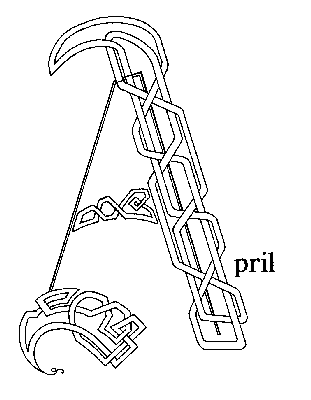



| On this page there are certain entries which give a genealogical researching tip e.g. "Remember something your grandfather told you about his father". Other entries include relationship strings denoting ancestors according to their relationship to you e.g. "Father's Mother". If you place your cursor overtop the relationship string, it should highlight in blue and become underlined, signifying that it is an active link. Click on the link and you will access a linked page on which you may enter data regarding that particular ancestor. By clicking on your browser's 'back' button, you will be returned to this page, and the relationship string will be changed to green. |
![]() April 1
April 1
| Father's Father's Father's Mother's Mother's Father |
![]() April 2
April 2
| Father's Father's Father's Mother's Mother's Mother |
![]() April 3
April 3
| Father's Father's Mother's Father's Father's Father |
![]() April 4
April 4
| Father's Father's Mother's Father's Father's Mother |
![]() April 5
April 5
| Father's Father's Mother's Father's Mother's Father |
![]() April 6
April 6
| Father's Father's Mother's Father's Mother's Mother |
![]() April 7
April 7
| Visit a museum and imagine how people used the everyday things exhibited there. Keep in mind that the items you see arranged carefully in glass cases, or hung from the walls, were actually used by people who (like yourself, reading this on a computer screen) didn't think the item was anything special or extraordinary. |
![]() April 8
April 8
| Father's Father's Mother's Mother's Father's Father |
![]() April 9
April 9
![]() April 10
April 10
| Father's Father's Mother's Mother's Father's Mother |
![]() April 11
April 11
| Look for recipes for 'ethnic dishes' that originated in the country of your ancestors. |
![]() April 12
April 12
| Father's Father's Mother's Mother's Mother's Father |
![]() April 13
April 13
| Father's Father's Mother's Mother's Mother's Mother |
![]() April 14
April 14
| Call a cousin on the telephone and tell him/her about one of your mutual ancestors. By sharing what information you have found with a cousin, that cousin might be motivated to tell you what he/she also knows about the mutual ancestor. |
![]() April 15
April 15
| Father's Mother's Father's Father's Father's Father |
![]() April 16
April 16
| Father's Mother's Father's Father's Father's Mother |
![]() April 17
April 17
| Read folk and fairy tales from the country(s) of your ancestors. |
![]() April 18
April 18
| Father's Mother's Father's Father's Mother's Father |
![]() April 19
April 19
| Father's Mother's Father's Father's Mother's Mother |
![]() April 20
April 20
| Father's Mother's Father's Mother's Father's Father |
![]() April 21
April 21
| Father's Mother's Father's Mother's Father's Mother |
![]() April 22
April 22
| Father's Mother's Father's Mother's Mother's Father |
![]() April 23
April 23
| Obtain a book on handwriting samples and name abbreviations for your ancestors' country. |
![]() April 24
April 24
![]() April 25
April 25
| Father's Mother's Father's Mother's Mother's Mother |
![]() April 26
April 26
| Father's Mother's Mother's Father's Father's Father |
![]() April 27
April 27
| Father's Mother's Mother's Father's Father's Mother |
![]() April 28
April 28
| Father's Mother's Mother's Father's Mother's Father |
![]() April 29
April 29
| Father's Mother's Mother's Father's Mother's Mother |
![]() April 30
April 30
| Father's Mother's Mother's Mother's Father's Father |
